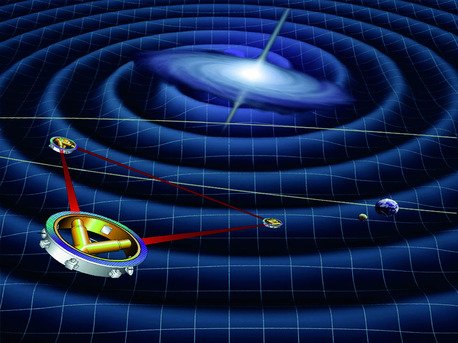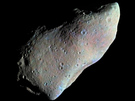Lisa to find gravitational waves
Will Lisa prove Einstein right?
 © ESA
|
The diagram shows the three satellites of the LISA mission. They lie at the corners of a triangle whose sides are three million miles long. If a ripple in space is caused, for example, by the gravitational waves of a massive black hole, the distance between the satellites will change. These minute changes in distance will be measured using lasers.
Einstein's theory predicts the existence of what are known as gravitational waves. Gravitational waves change the structure of space-time; they compress and stretch space – similar to the way that a wave ripples through water when a stone is thrown into it. Gravitational waves are created when a mass accelerates. Exploding stars and black holes cause particularly strong gravitational waves. Changes in the gravitational field – that is, the distortions of space which occur as a result – spread at the speed of light as gravitational waves. Such a gravitational field causes a short-term, cyclical compression and expansion of space; the distances between objects or any two points in space change.
LISA – a giant triangle in space to prove the existence of gravitational waves.
Proving the existence of gravitational waves should actually only require two test masses, with the change in the distance between them being measured. The problem is that the effect of gravitational waves is extremely small and thus very difficult to prove. If the test objects are one mile apart, the change in distance between them only amounts to a fraction of the diameter of an atom. That is why Einstein thought that gravitational waves would probably never be proved. And indeed, there have only been indirect indications so far – arising from astronomical observations.
Perhaps we will not have to wait that long for a direct proof of gravitational waves. Alongside several gravitational wave detectors on Earth, hopes rest on LISA (Laser Interferometer Space Antenna). LISA is to be launched into space in 2020 and will consist of three satellites equipped with test masses. The three satellites will lie at the corners of a triangle whose sides each measure three million miles in length. If a ripple in space is caused by gravitational waves, the distance between the satellites will change. These minute changes in distance will be measured using lasers.
German Aerospace Center
Lisa to find gravitational waves
Will Lisa prove Einstein right?
 © ESA
|
The diagram shows the three satellites of the LISA mission. They lie at the corners of a triangle whose sides are three million miles long. If a ripple in space is caused, for example, by the gravitational waves of a massive black hole, the distance between the satellites will change. These minute changes in distance will be measured using lasers.
Einstein's theory predicts the existence of what are known as gravitational waves. Gravitational waves change the structure of space-time; they compress and stretch space – similar to the way that a wave ripples through water when a stone is thrown into it. Gravitational waves are created when a mass accelerates. Exploding stars and black holes cause particularly strong gravitational waves. Changes in the gravitational field – that is, the distortions of space which occur as a result – spread at the speed of light as gravitational waves. Such a gravitational field causes a short-term, cyclical compression and expansion of space; the distances between objects or any two points in space change.
LISA – a giant triangle in space to prove the existence of gravitational waves.
Proving the existence of gravitational waves should actually only require two test masses, with the change in the distance between them being measured. The problem is that the effect of gravitational waves is extremely small and thus very difficult to prove. If the test objects are one mile apart, the change in distance between them only amounts to a fraction of the diameter of an atom. That is why Einstein thought that gravitational waves would probably never be proved. And indeed, there have only been indirect indications so far – arising from astronomical observations.
Perhaps we will not have to wait that long for a direct proof of gravitational waves. Alongside several gravitational wave detectors on Earth, hopes rest on LISA (Laser Interferometer Space Antenna). LISA is to be launched into space in 2020 and will consist of three satellites equipped with test masses. The three satellites will lie at the corners of a triangle whose sides each measure three million miles in length. If a ripple in space is caused by gravitational waves, the distance between the satellites will change. These minute changes in distance will be measured using lasers.
German Aerospace Center








